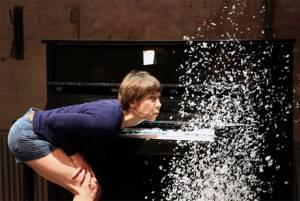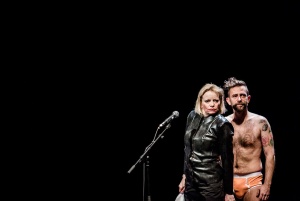 My experience with modul-dance began in 2010 at the first meeting held at the Maison de la Danse in Lyon. A group of about forty dance artists and professionals gathered there to get acquainted with each other. As opposed to what often happens, modul-dance endowed itself with the means to create a “true network” by inviting all these people to meet. Occasions rarely arise to create strong ties between structures and artists, and modul-dance came to allow just that.
My experience with modul-dance began in 2010 at the first meeting held at the Maison de la Danse in Lyon. A group of about forty dance artists and professionals gathered there to get acquainted with each other. As opposed to what often happens, modul-dance endowed itself with the means to create a “true network” by inviting all these people to meet. Occasions rarely arise to create strong ties between structures and artists, and modul-dance came to allow just that.
What immediately struck my interest was the European dimension of this project. My company is based in two countries: Switzerland and France, and my work is deeply marked by this artistic “double life”. In each project I ask myself how these two countries, these two cultures, these two artistic worlds will influence my work. Even if they are neighbours, the politics, codes and ways of thinking of these countries differ, and this has enriched my artistic research. For example, Je pense comme une fille enlève sa robe is a piece that reflects on prostitution since this activity is legal in Switzerland and forbidden in France. In my research, I have met prostituted persons and worked in associations in both countries to understand how their practice is influenced by the political and cultural context of the countries where they live. Consequently, far from being provocative, this piece simply poses some questions and shows how the body and ways of thinking are highly subjective.
Dance has this “magical power” of conveying questions, emotions or sensations through the body, and of transmitting this body language beyond frontiers. For me, module-dance is the only network, as far as I know, which sets itself in this perspective of communication and exchange across countries, and that endows itself with the means required to do so... it is a great opportunity to form part of it and this is what has interested me the most.
I’ve been able to take advantage of the three modules:
- Production: at the ADC in Geneva. This theatre has the tremendous virtue of programming certain pieces for a long stay. I’ve been lucky enough to dance ten evenings in a row, allowing me to build a solid piece. In each successive performance I took the liberty of trying out new things: I changed a movement here and there, prolonged some scenes and eliminated others, listened to the audience’s feedback and if certain aspects seemed interesting to me, I worked further on them... at night! I worked under excellent conditions with a financial support that was of great help in this respect.
- Residency: at the Maison de la Danse in Lyon. I was working on a project that arose at the CulturesFrance residency “Villa Médicis-Hors les murs”, which I did in Tokyo. I met two Japanese dancers there and we were quickly struck by the difference between the professional situation of Japanese and European dance artists. For example, at that time they were working on a piece presented in a theatre with about 400 seats, and each dancer had the obligation to sell 35 tickets. Not only were the dancers unpaid, but they also had to reimburse the theatre for the tickets that went unsold! Conversely, they were amazed to learn that I was paid simply for doing research for 4 months in Japan. Despite their difficult financial situation, I was struck by the dynamic spirit of the Japanese dancers –who are sometimes much more active than some of their European counterparts–, combining personal projects, daily dance courses, creations, performances and side jobs. That made me want to create a project on these exchanges and on these cultural differences. We set to work on the creation of this piece in Lyon. When Airi and Kazuma saw the words “Maison de la Danse” at the entrance, they couldn’t get over their surprise: how could such a big building be devoted solely to dance? That residency was very enriching and very pleasant, especially thanks to the two Japanese dancers who, just the opposite of the French artists, raved about everything: they loved to dance in the big beautiful studio that was made available to us and to be able to use it for as many hours as we wished. They were surprised to receive per diems for our meals and delighted that we were provided accommodation which, on top of it all, was located right in front of the Maison de la Danse. That was in May 2011, just after the big earthquake, which we talked about a lot during the 7 days of the residency, and thanks to these people I came to understand a great deal of things about Japanese culture. Deproduction is performed in English and it is a piece that has been very well received by the public. It presents on stage, in a tone infused with humour, the experiences that the three of us had between Tokyo and Lyon.
- Presentation: at Mercat de les Flors in Barcelona. We have presented Je pense comme une fille enlève sa robe. It was the first time that I performed this piece in Spain and the audience was very receptive. After the performance, several people stayed on to ask me some questions. It was highly enriching to be able to talk about prostitution and the different relationships with the body, with people who live in a different country with a different system. These exchanges and reflections make it possible to give the piece a dimension that extends beyond the stage and this is a part of dance that interests me very much. We ended up by spending the evening with this Spanish audience, dancing and drinking sangria until late!
My latest experience with modul-dance took place in Tilburg this autumn on the occasion of the annual modul-dance conference. I found that it was extremely important that artists of different generations and partners were able to meet again in order to strengthen our ties. We got the chance to get to know one another better and to make new acquaintances. I thought it was fantastic to be able to exchange ideas about the good and bad aspects of our reciprocal experiences and to share them with partners during those three days. I consider it important that artists can take part in the development of this network in order to keep it from becoming a “show market” like so many others that exist today. I appreciate the fact that modul-dance seeks to create a true space-time continuum that allows artists and professionals to look for ideas together with a view to improving the operation of the network.
Victor Hugo said “Expression has its frontiers, thought has none”, and this is precisely the experience that I would like to continue to enjoy in modul-dance... a “ping-pong” of art, ideas, experiences, shows and artists bouncing back and forth between all these countries.
Picture: © Dorothée Thébert



